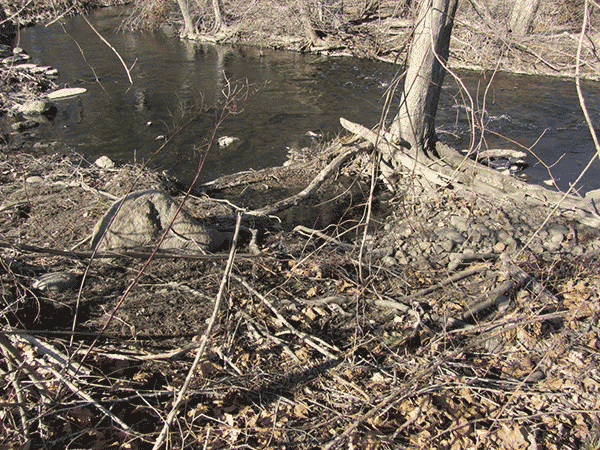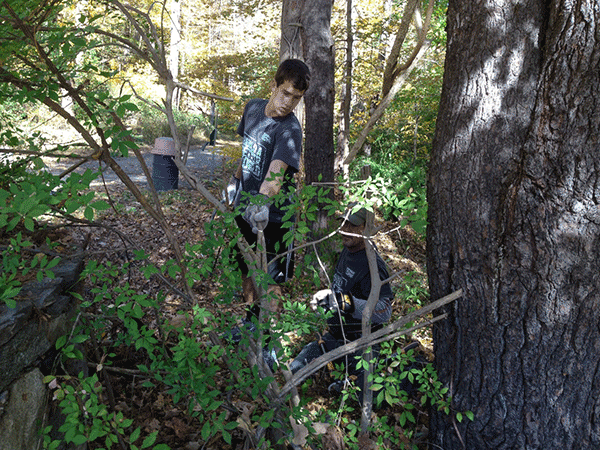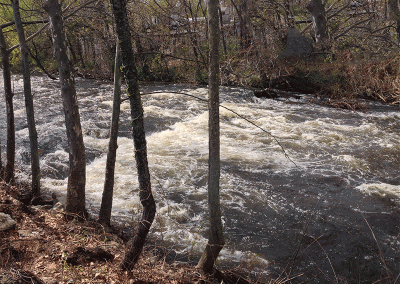Threats to the Watershed
Norwalk River Watershed Association



Pesticide and Fertilizer Use
The use of pesticides and the tendency to over-fertilize on private lawns and by municipalities on public green spaces, remain major threats to water quality. Read more on these issues here:
- Connecticut Bans Pesticide Use On School Grounds, Should You Use Them In Your Yard?
- How To Maintain A Beautiful Lawn Without Contaminating Waterways With Excess Fertilizer
- What Restrictions Are There On State and Municipal Pesticide Use?
The Chemical Contaminant PFAS
PFAS, Per- and polyfluoroalkyl substances are a group of manufactured chemicals that are collectively referred to as PFAS and are used in a variety of products and applications including non-stick cookware, upholstered furniture, clothing, food packaging, and firefighting foam used to extinguish petroleum fires. These substances are not found naturally in the environment. They do not break down easily and are extremely persistent in both the environment, especially in water, and the human body. It is estimated that there are approximately 3,000 PFAS in production.
The CT legislature failed to vote on a bill to restrict these chemicals in 2019 and four days after the legislative session ended, 40,000 gallons of PFAS containing fire fighting foam leaked out of a hangar at Bradley International Airport and flowed into the Farmington River! On July 9th, Governor Lamont formed a taskforce to make recommendations on how to manage PFAS contamination. This is good news but we want to make sure comprehensive steps are taken to 1) restrict firefighting foam, 2) restrict other sources of contamination like food packaging, 3) implement strict water testing guidelines and 4) set a health protective drinking water standard. To learn about CT bills and how you can support them, check our advocacy page.
PFAS chemicals have contaminated groundwater and drinking water across the country. A recent report estimates that 610 drinking water sources in 43 states contain PFAS, potentially impacting millions of Americans. These chemicals are are persistent—meaning they don’t break down, which is why they are known as “forever chemicals,” and accumulate in our bodies and the environment. In the environment, they are also mobile! They leach into groundwater and spread. They are found in fish, wildlife and humans and they’re toxic! PFAS chemicals are linked to kidney and testicular cancers, liver disfunction, hormone disruption, thyroid disease, reproductive disorders, infertility, low birth weights and even resistance to vaccines!
Storm Water Runoff
Many contaminants reach the Norwalk River through stormwater runoff from highways, parking lots and even our own driveways and rooftops. Stormwater runoff is rain and melted snow that flows off of these impervious surfaces directly into waterways without first percolating through the ground. The natural percolation process cleans debris, oils, gasoline and other contaminants from stormwater.
The EPA, local municipalities and homeowners all play an important role in helping manage stormwater runoff. Some strategies homeowners and cities use include green roofs, permeable pavements, rain barrels and rain gardens. Green roofs are flat roofs planted with gardens that catch and filter rainwater. Permeable pavement is just what it sounds like: sidewalks, parking lots and driveways made of pavement that allows water to seep through it instead of run off of it. Available at hardware stores, rain barrels catch rooftop water from gutter systems for use in watering lawns and gardens, washing cars and dogs, and filling swimming pools. More information about rain barrels here. Rain gardens catch runoff from paved surfaces and also from gutter systems. They are shallow depressions planted with perennials (native plants are best) designed to catch water and allow it to percolate through the ground instead of running directly into storm drains, streams or rivers. More information on rain gardens and how to install them here. NRWA in association with the University of Connecticut’s NEMO program installed a model rain garden in the Norwalk River watershed at the Wilton Playshop on Lovers Lane in Wilton. Stop by and see it just off the back patio.
Riverbank Destruction
The Norwalk River’s banks have undergone modification by people in many places, often to the detriment of the river’s water quality and to the plant and animal life that lives along the river.
Loss of Riparian Buffer Zones
The area along the banks of the river is known as the riparian zone and it is vital to the health of the watershed ecosystem. A healthy riparian zone is one where native plants are allowed to flourish. The area should be protected from mowing or any kind of construction. Pristine streamside “riparian” zones are vital because they:
- Filter debris and contaminants from stormwater runoff
- create shade which lowers water temperature and helps provide a stable habitat for aquatic life
- prevent erosion by stabilizing banks–the roots and branches of riverbank vegetation help hold soil in place and also help reduce the velocity of flowing water
- provide food and shelter in the form of leaves, fruits and woody debris that fall into the river to both aquatic life and wildlife living on riverbanks
- provide habitat and travel corridors for wildlife
- act as a flood zone safeguarding property during periods of high water
Presence of Invasive Plant Species
In Connecticut, we have more than 100 types of plants that have been classified as invasive. While many of these were first introduced for their ornamental interest, they have ‘escaped’ their individual landscapes into far-flung areas of our environment, resulting in numerous negative impacts on the entire ecosystem. Invasive plants provide little or nothing for native wildlife to eat. The seeds and berries of native plants are crucial for native insects, butterflies, moths and other pollinators as well as birds and other small animals. Becoming familiar with the common invasives is the first step toward taking action to halt their growth and spread on your own property and beyond, into the wetlands, meadows and forests. When possible, encouraging existing natives or replacing invasives by planting native species can help restore our neighborhoods to their natural beauty and healthy conditions.
Why Do Invasives Matter?
Common Invasives and Beautiful Native Alternatives.
Complete List of CT Invasive Plant Species.
Habitat Loss
Much of the “original habitat” of the Norwalk River Watershed has been altered or destroyed over the past 150 years. Population growth and attendant development, roads, dams, channelization, rip rap, sewer discharges, accidental spills, and nonpoint-source pollution from fertilizers, pesticides, road salt and sand, warming asphalt, and other impacts from human activities have led to the extensive loss and continuing incremental destruction of natural habitats and degradation of water quality. In addition, invasive plants and animal species (e.g., deer) are altering habitats and threatening biological diversity.
Contamination from Septic Systems and Sewage Plants
Leakage From Septic Systems and Septic Storage Tanks
The most serious problem in water-quality tests on the Norwalk River is the presence of bacteria, part of which may come from unmaintained or malfunctioning septic systems and underground storage tanks. More information about septic-system maintenance can be found. Questions about local regulations and practices should be directed to local health departments.
Sewage Plant Outflows
Discharges from “point sources” such as wastewater treatment plants and industrial discharge pipes are not nearly as severe a problem as they were twenty or thirty years ago. Despite the many improvements, though, some serious areas of concern remain. As of 2015, of the 10 wastewater treatment plants that still discharge directly into Long Island Sound or a river that flows into the Sound, 6 are in Connecticut (4 are in New York). The Norwalk wastewater treatment plant is one of these, and it empties into the Norwalk River. Pipes carrying stormwater are connected to those carrying sewage, so during storms when the water volume exceeds what the treatment plant can handle, this mixture of runoff and sewage spills directly into the River and flows into the Sound. Other problems exist at the two treatment plants in Ridgefield and many monitoring sites along the Norwalk River tend to exceed the CT DEP Class B river criterion for E. coli bacteria.
Sewage treatment plants along the river use ultra violet (UV) lights to kill bacteria in treated sewage water before returning it to the river. The plants are only required by law to use their lights to kill bacteria in the warmer months, May through September, when the community uses the river recreationally. One plant, the Georgetown plant, has elected to keep its lights working all year, and we applaud this important effort to keep the watershed healthy. In addition, the Georgetown plant upgraded its filter system in 2014, which will also help protect the river. The Ridgefield sewage treatment plant uses its UV lights two months longer than required, from April through October. A smaller third plant along Route 7 only uses its lights from May through September.
